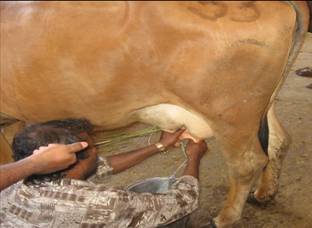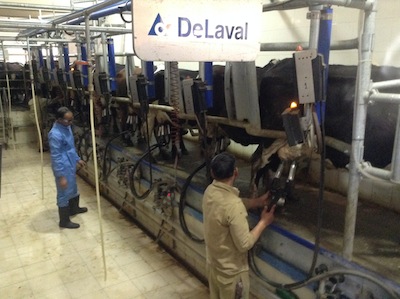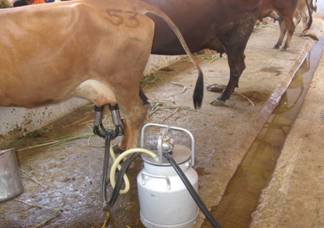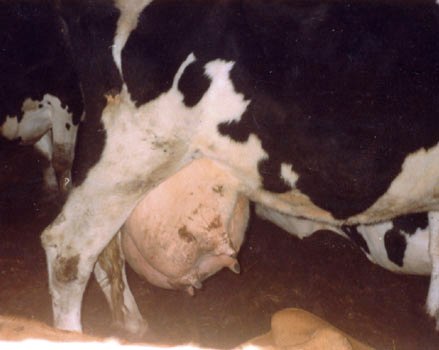
|
||||||||
| Livestock :: Cattle :: Milking Method | Home | |||||||
METHODS OF MILKING Hand milking and machine milking are the two methods of which in India . Hand Milking Cows are milked from left side. after let down of milk, the milker starts milking teats either cross wise or fore quarters together and then hind quarters together or teats appearing most distended milked first few streams of fore milk from each teat be let on to a strip cup. This removes any dirt from the teat canal and gives the operator a chance to detect mastitis. Milking is done either by stripping or by full hand method. Stripping is done by firmly holding the teat between the thumb and fore finger and drawing it down the length of the teat and at the same time pressing it to cause the milk to flow down in a stream. Grasping the teat with all the five fingers and pressing it against the palm does fisting or full hand milking. The teat is compressed and relaxed alternatively in quick succession, thus the method removes milk much quicker than stripping as there is no loss of time in changing the position of the hand. Further full hand method is superior to stripping as it stimulates the natural suckling process by calf and moreover the method exerts an equal pressure on the large teats of cows and buffaloes. Many milkers during milking tend to bend their thumb against the teat. The method is known as knuckling which should always be avoided to prevent injuries of the teat tissues. Thus milking should always be done with full hand unless the teats are too small or towards the completion of milking. The first few strips of milk from each quarter should not be mixed with the rest of the milk as the former contains highest number of bacteria.
Machine Milking Modern milking machines are capable of milking cows quickly and efficiently, without injuring the udder, if they are properly installed, maintained in excellent operating conditions, and used properly. The milking machine performs two basic functions.
Advantage The advantages of this milking machine are manifold. It is easy to operate, costs low, saves time as it milks 1.5 litre to 2 litres per minute. It is also very hygienic and energy-conserving as electricity is not required. All the milk from the udder can be removed. The machine is also easily adaptable and gives a suckling feeling to the cow and avoids pain in the udder as well as leakage of milk.
CLEAN MILK PRODUCTION: Milk containing dirt, dust, foreign materials high bacterial count and with off, flavour is called a contaminated milk. Milk is contaminated by various sources like Udder, Exterior of cows body, milking barn, flies, milker, utensils etc. On consumption of contaminated milk, one may get a’ number of health problems. The sources for contamination are discussed below with their relative importance. Udder Unsanitary conditions of milking barns and bedding of the animal causes bacterial growth. Such bacteria may enter in to the udder through teat canal, which causes infection the udder like mastitis resulting contamination of milk. The fore milk may be discarded as it contains high bacterial count. Complete milking should be done. Incomplete milking may lead to infection of the udder. Exterior of cow’s body Bacteria present on the animal body may enter in to the milk at the time of milking. Maintenance of, clean skin, washing flank and *udder with clean damp cloth before milk reduces the contamination from this source. Milking barns Milking barns with good ventilation and neat flooring avoids contamination from this sources, Dry feeds or forage should be fed after milking. Flies and other vermin External parasites like flies, lice; mosquitoes etc may have their entry in to milk. So care should be taken to avoid these parasites from the barn by spraying fly spoors or by fly traps. Breeding places for these parasites like stagnant water, moist atmosphere etc may be avoided. Milker Milker is directly responsible in producing good quality milk. Dirty hands and clothing of the milker may be the source of contamination. Several bacterial diseases may transmit from the milker, or handler to the consumer through milk. Persons suffering from diseases like T.B, Typhoid fever, diphthiria may not be employed for milking. Dirty habits like smoking, drinking should be avoided. Utensils Utensils are the containers or equipments in which the milk is handled, processed, stored or transported. Clean sanitized, smooth copper free and dry utensils may be used for handling milk. Milking method Wet hand milking and fisting causes contamination of milk. Milkers in rural moisten their fingers with milk, water or even saliva, while milking. This should be avoided. Wet hand milking should be avoided. Wet hand milking makes the teats look harsh and dry chokes, cracks and sores appear which causes contamination. Twisting causes damages to the teat tissue which leads to udder infection. So dry hand milking may be practiced to avoid contamination of milk. Major contamination of milk is caused by bacterial entry. So steps to be taken to, monitor such bacterial entry like avoiding unsanitary conditions of the barn. Milker, Utensils and avoiding unfair milking practices. STEPS IN CLEAN MILK PRODUCTION
(Source: http://bieap.gov.in/DairyAnimalManagementTheory.pdf ) MILK HYGIENE Milk is sterile when secreted into an uninfected udder. Contamination occurs during and after milking. Exclude milk from clinical mastitis cases to avoid high bacterial counts. Use mastitis control routines at each milking to reduce the proportion of infected cows and clinical mastitis cases. Avoid contamination from dirty udders and teats by good cow housing and grazing management. Wash off visible dirt from udders and teats prior to applying the teat-cups. If udder washing is necessary, then drying afterwards is essential. Individual paper towels for both washing and drying are preferable to udder cloths. Clean and disinfect milking and ancillary equipment after use, paying particular attention to milk contact surfaces which are a main source of contamination. The milk secreted into an uninfected cow's udder is sterile. Invariably it becomes contaminated during milking, cooling and storage, and milk is an excellent medium for bacteria, yeasts and moulds that are the common contaminants. Their rapid growth, particularly at high ambient temperatures can cause marked deterioration, spoiling the milk for liquid consumption or manufacture into dairy products. This can be avoided by adopting the simple, basic rules of clean milk production.
Other sources of contamination Under normal grazing conditions, cows' udders will appear clean and therefore washing and drying will be unnecessary. Otherwise, any visible dirt must be removed using clean, running water, individual paper towels or cloths in clean water to which a disinfectant has been added (eg. sodium hypochlorite at 300 ppm). If udder cloths are used, provide a clean cloth for each cow. After each milking wash and disinfect them and hang up to dry. Disposable paper towels are preferable and more effective for drying after washing. When cows are housed or graze in heavily stocked paddocks, external udder surfaces are usually grossly contaminated with bacteria even when they appear visibly clean, therefore routine udder preparation procedures should be followed. Whenever udders are washed they should be dried. Cleaning milk production equipment It is virtually impossible with practical cleaning systems to remove all milk residues and deposits from the milk contact surfaces of milking equipment. Except in very cold, dry weather, bacteria will multiply on these surfaces during the interval between milking, so that high numbers ( 106 per m2) can be present on visually clean equipment. A proven cleaning and disinfectant routine is required so that with the minimum of effort and expense, the equipment will have low bacterial counts as well as being visually clean. The essential requirements are, to use milking equipment with smooth milk contact surfaces with minimal joints and crevices, an uncontaminated water supply, detergents to remove deposits and milk residues and a method of disinfection to kill bacteria. Water supplies Unless an approved piped supply is available it must be assumed that water is contaminated and therefore hypochlorite must be added at the rate of 50 ppm to the cleaning water. Hard water (ie. high levels of dissolved calcium and other salts) will cause surface deposits on equipment and reduce cleaning effectiveness. In such case, it is necessary to use de-scaling acids such as Sulphuric or phosphoric, periodically. Detergents and disinfectants Detergents increase the 'wetting' potential over the surfaces to be cleaned, displace milk deposits, dissolve milk protein, emulsify the fat and aid the removal of dirt. Detergent effectiveness is usually increased with increasing water temperature, and by using the correct concentration and time of application. Detergents contain inorganic alkalis (eg. sodium carbonate and silicates and tri-sodium phosphate), surface-active agents (or wetting agents), sequestering (water-softening) agents (eg. polyphosphates) and acids for de-scaling. Many proprietary, purpose-made detergents are usually available, but otherwise, an inexpensive mixture can be made to give a concentration in solution of 0.25% sodium carbonate (washing soda) and 0.05% polyphosphate (Calgon). Disinfectants are required to destroy the bacteria remaining and subsequently multiplying on the cleaned surfaces. The alternatives are either heat applied as hot water or chemicals. Heat penetrates deposits and crevices and kills bacteria, providing that correct temperatures are maintained during the process of disinfection. The effectiveness of chemicals is increased with temperature but even so, they do not have the same penetration potential as heat and they will not effectively disinfect milk contact surfaces which are difficult to clean. When hot water alone is used, it is best to begin the routine with water at not less than 85°C, so that a temperature of at least 77°C can be maintained for at least 2 minutes. Dairy disinfectants are sold as concentrates and in this form are often corrosive and damaging to the skin and eyes. They should always be so labeled, handled with care and stored out of reach of children. Disinfectants should not be mixed unless specific instructions are given and disinfectant powders must be kept dry. If any concentrated detergent and/or disinfectant comes in contact with the skin or eyes the affected area should be washed immediately with copious amounts of clean water. Clean and disinfect the ancillary equipment such as coolers, foremilk cups and udder cloths effectively using hot detergent/disinfectant solution.Drain and store all the milking and ancillary equipment in a clean place such as the dairy of the milking premises. Milking premises The milking premises should have a dairy or suitable place equipped with a piped hot and cold water supply, a wash trough, brushes, a work surface, storage racks and cupboards and, if necessary, a vacuum pipeline connection. In addition, it is advisable to have a dairy thermometer (0°C - 100°C), rubber gloves and goggles for use when handling chemicals. Daily routines Daily routines for cleaning and disinfecting vary with the size and complexity of the milking installation but will include methods of removing dirt and milk from the equipment followed by disinfection. For hand milking, bucket and direct-to-can milking machines, basic manual methods of cleaning and sterilizing are adequate and effective. For pipeline milking machines in-situ (in-place) systems are necessary. Milk can become grossly contaminated from bacteria on ancillary equipment which must also be cleaned and disinfected effectively. Coolers, either the corrugated surface or the turbine in-can, can best be cleaned and disinfected manually and stored in the dairy to drain. Refrigerated bulk milk tanks can be cleaned either manually using cold or warm detergent/disinfectant solutions, or for the larger tanks, by automatic, programmed equipment. In either case, a cold water chlorinated (50 ppm) rinse proceeds and follows the washing solution. Foremilk cups can be a potent source of bacterial contamination and need to be cleaned and disinfected after each milking. They should then be stored in the dairy to drain. It is important with any method of cleaning that the equipment is drained as soon as possible after washing for storage between milking. Bacteria will not multiply in dry conditions but water lodged in milking equipment will, in suitable temperatures, provide conditions for massive bacterial multiplication. Equipment with poor milk contact surfaces, crevices and large number of joints, remaining wet between milking in ambient temperatures above 20°C, should receive a disinfectant rinse (50 ppm available chlorine) before milking begins. (Source: www.fao.org ) |
||||||||
| © 2009-15 TNAU. All Rights Reserved. |
||||||||



